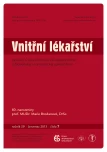Tyrosine kinase inhibitors – major change in the prognosis of chronic myeloid leukaemia
Authors:
H. Klamová
Authors‘ workplace:
Ústav hematologie a krevní transfuze Praha, ředitel prof. MU Dr. Marek Trněný, CSc.
Published in:
Vnitř Lék 2013; 59(7): 624-626
Category:
Overview
Chronic myeloid leukaemia (CML) is an example of a tumour disease, in which the discovery of its molecular principle resulted in the development of the specific targeted molecular treatment with the first representative being imatinib. The introduction of other tyrosine kinase inhibitors, nilotinib and dasatinib, into the clinical practice meant not only a revolutionary change in the treatment approach to CML but literally an epochal improvement of the prognosis and quality of life. The disease with an originally fatal prognosis in patients diagnosed in the chronic stage has changed into a disease with the expected survival rate median estimated to be more than 25 years.
Key words:
chronic myeloid leukaemia – tyrosine kinase inhibitors – imatinib – dasatinib – nilotinib
Sources
1. Hehlmann R, Hochhaus A, Baccarani M. Chronic myeloid leukaemia. Lancet 2007; 370: 342– 350.
2. Rohrbacher M, Berger U, Hochhaus SA et al. Clinical trials underestimate the age of chronic myeloid leukemia (CML) patients. Incidence and median age of Ph/ BCR‑ ABL‑ positive CML and other chronic myeloproliferative disorders in a representative area in Germany. Leukemia 2009; 23: 602– 604.
3. Faderl S, Talpaz M, Estrov Z et al. Chronic myelogenous leukemia: biology and therapy. Ann Intern Med 1999; 131: 207– 219.
4. Kantarjian HM, OʼBrien S, Cortes JE et al. Complete cytogenetic and molecular response to interferon‑alfa‑based therapy for chronic myelogenous leukemia are associated with excellent long‑term prognosis. Cancer 2003; 97: 1033– 1041.
5. Drucker BJ, Tamura S, Buchdunger E et al. Effect of selective inhibitor of the Abl tyrosine kinase on the growth of Bcr‑ Abl positive cells. Nat Med 1996; 2: 561– 566.
6. Hochhaus A, OʼBrien SG, Guilhot F et al. Six‑year follow‑up of patients receiving imatinib for the first‑line treatment of chronic myeloid leukemia. Leukemia 2009; 23: 1054– 1061.
7. Goldman JM. Treatment strategies for CML. In: Rowe JM, Hehlman R (eds). Best Practice & Research. Clinical Haematology 2009; 22: 303– 313.
8. Hochhaus A, Kantarjian HM, Baccarani M et al. Dasatinib induces notable hematologic and cytogenetic responses in chronic‑ phase chronic myeloid leukemia after failure of imatinib therapy. Blood 2007; 109: 2303– 2309.
9. Kantarjian HM, Giles F, Gattermann N et al. Nilotinib (formerly AMN107), a highly selective BCR‑ ABL tyrosine kinase inhibitor, is effective in patients with Philadelphia chromosome‑ positive chronic myelogenous leukemia in chronic phase following imatinib resistance and intolerance. Blood 2007; 110: 3540– 3546.
10. Cortes JE, Kantarjian HM, Brümmendorf TH et al. Safety and efficacy of bosutinib (SKI‑ 606) in chronic phase chronic Ph+ CML patients with resistance or intolerance to imatinib. Blood 2011; 118: 4567– 4576.
11. Bocchia M, Gentili S, Abruzzese E et al. Effect of a p210 multipeptide vaccine associated with imatinib or interferon in patients with chronic myeloid leukaemia and persistent residual disease: a multicentre observational trial. Lancet 2005; 365: 657– 662.
Labels
Diabetology Endocrinology Internal medicineArticle was published in
Internal Medicine

2013 Issue 7
Most read in this issue
- Relationship of bilirubin to diseases caused by increased oxidative stress
- Cystic tumors of the pancreas – our experience with diagnostics
- Acute pancreatitis – new developments in treatment
- Liver disorders in diabetic patients
